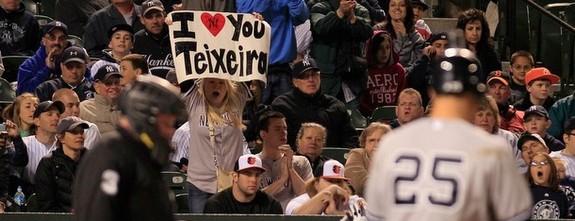
Over the last two days we’ve taken a look at the two different Mark Teixeiras to help get an idea of his where his offensive decline is coming from. There’s a right-handed hitting version of Teixeira, who continues to mash and has actually shown signs of improving in recent years, not decline. Then there’s a left-handed hitting version of Teixeira, who has racked up fewer and fewer hits over the last three years. The good news that he’s still hitting the ball over the fence and isn’t striking out any more or walking any less, the problem is isolated to the balls he’s putting in play from the left side of the plate.
Today we’re going to look at those balls in play as a left-handed batter. This post is very image-heavy, so I’ve added a Read More button just to make sure we don’t have any loading issues with the front page. You have been forewarning, there are a bunch of images on the other side of that jump…
With some help from Texas Leaguers, we can separate Teixeira’s spray charts by handedness. Since we already know that his right-handed swing is a-okay, we’re only going to focus on the data as a left-handed hitter. We’re going to start with 2008 simply because the batted ball data doesn’t go back any further. In fact, even the 2008 data set isn’t 100% complete. It’s still more than enough to help us out, however. Take note of the batted ball percentages in the image caption…

Most of Teixeira’s left-handed power in 2008 — his walk year split between the Braves and Angels — is to the pull side, which isn’t surprising. Just about every 30+ homer guy is going to do most of their damage by pulling the ball. Teixeira still hit the ball with authority the other way as a lefty however, including two homers to left plus about a dozen other balls hit to warning track-ish.
Check out the right side of the infield though. Tex was hitting a ton of ground balls in that direction before he ever came to the Yankees, so it’s not like the shift came out of nowhere. Here, check this out…
That (low-quality) screen cap comes from this highlight clip of Gabe Gross robbing Teixeira of an extra-base hit at the wall on August 19th, 2008. It’s not the exaggerated shift we see today, but you can see Rays’ second baseman Akinori Iwamura swung around and playing much deeper than a second baseman normally would with no one on base. Tampa was trying to exploit Tex’s tendency to hit the ball on the ground to the right side before he ever wore pinstripes. Now let’s look at his batted balls in 2009, his first season in New York…
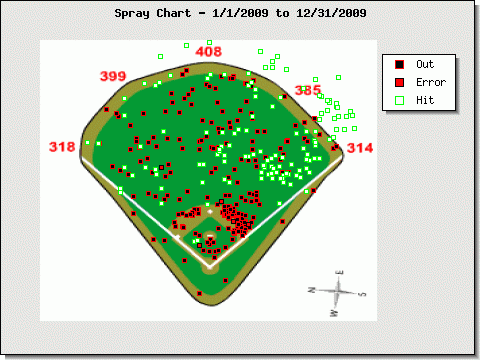
Again, most of the homers are to right field as expected, but there are fewer balls hit deep to the opposite field. Most of the ground balls were hit to the right side again, but the shift started to become a regular tactic around the league and the number of outs made in shallow right field increased. Let’s split the spray chart up just a little bit, starting with the first half (pre-All-Star break)…
Now here’s the second half, after the All-Star break…
The right side of the field is pretty similar, but the big difference is found in left and left-center field, right in front of the 399 sign. Teixeira didn’t hit as many balls to deep left field as a left-handed batter in the second half, indicating that he started to alter his swing in an effort to take advantage of the short porch in right as far back as 2009.
Let’s not obsess over left field, because there is other stuff going on here. The shift became more problematic mostly because more teams started to use it, but also take note of Teixeira’s fly ball percentage. He went from putting the ball in the air 40.1% of the time as a lefty in 2008 to 46.1% of the time in 2009. His infield pop-up rate barely changed (2.8% in 2008 and 3.2% in 2009), however. Fly balls have a tendency to go over the fence, but they also turn into routine outs more than any non-infield pop-up batted ball. Teixeira’s BABIP as a lefty went from .314 in 2008 to .290 in 2009. That’s a small enough changed to be ignored as just the usual year-to-year fluctuation of the stat, but it turned out to be a harbinger of things to come. Now let’s look at his 2010 spray chart…
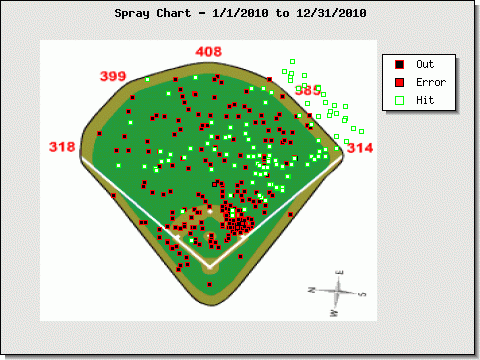
The ground ball to the right side thing really started to become an issue two seasons ago, and again we see a lesser amount of balls hit towards that 399 sign. Teixeira’s fly ball rate as a left-handed batter again rose, this time to 48.3%. His infield pop-up rate more than doubled as well. Unsurprisingly, his BABIP dropped again to .255. It’s hard to notice a drop from .314 to .290 when you’re watching games every day, but going from .314 to .290 to .255 is something fans can pick up on, and we all certainly did that summer. The shift gets most of the attention because it’s right there smacking us in the face, but the extra fly balls have been doing a number on Teixeira’s production as well. Let’s look at his 2011 spray chart now…
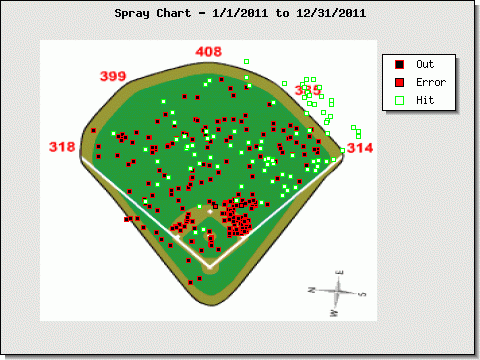
Things started to get really silly last season. Teixeira didn’t hit a ball anywhere near that 399 sign we’ve been using as reference, and the same ground ball to the right side and fly ball/infield pop-ups problems persist. He started swinging for the short porch back in 2009 and it’s gradually gotten worse and worse in the two full seasons since. Teixeira has gotten pull happy and that’s hurt because the shift is regularly used around the league, but the more serious problem is the uppercut he’s added to his swing. Look at how level his swing was in middle of 2008…
…compared to this swing from the other day…
You can see the uppercut Teixeira has added over the last few years. It’s pretty severe, and it’s led to all those increased fly balls and declining batting average. The shift is only one piece of the puzzle; he’s also made it easier for the defense to turn his balls in play into outs by knocking so many of them up in the air.
I’m going to tie a bow on all this with some kind of wrap-up post tomorrow, but again I want to point out that the shift isn’t the only reason Teixeira’s batting average and BABIP has declined from the left side of the plate. He’s developed some bad habits aiming for the short porch, specifically the uppercut that has led to so many more fly balls. I have no idea how much work it would take to correct something like that, but I can’t imagine it would be easy and/or happen overnight.
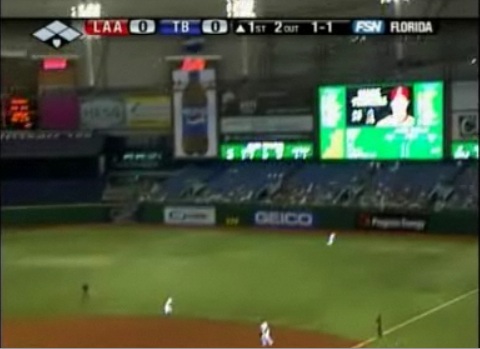
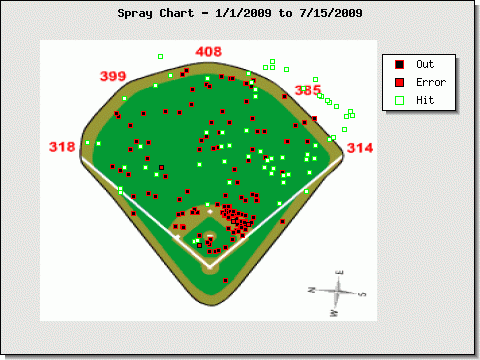

Leave a Reply
You must be logged in to post a comment.